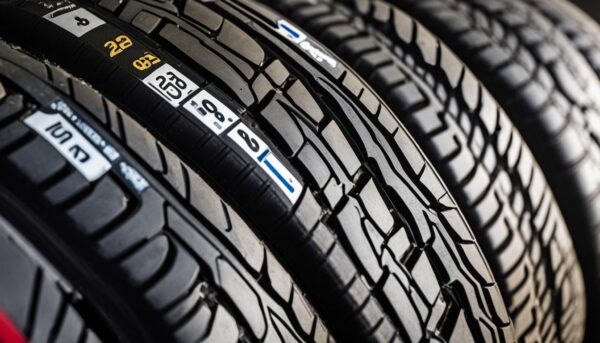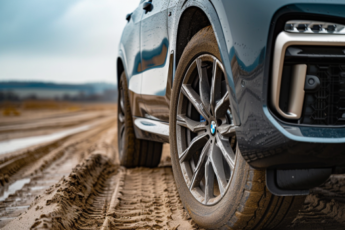Last Updated on 4 weeks
Your Ultimate Guide to Choosing the Best Types of Tires
Finding the perfect types of tires for your vehicle can be daunting, given the vast range of tire types and tire categories available. However, choosing the right tires is essential to ensure your car’s safety, performance, and longevity. This comprehensive guide will walk you through the key factors you need to consider, including the specific requirements of your vehicle, your driving habits, seasonal weather variations, and budget constraints. Let’s dive in and learn about your vehicle’s best car tire types!
Key Takeaways
- Identify your vehicle’s specific tire requirements and preferences based on size, vehicle type, driving conditions, and performance expectations.
- Please explore the most common tire categories, including all-season, summer, and winter tires, and their advantages and disadvantages.
- Consider the impact of weather and terrain on your tire choice, especially when selecting between all-season and climate-specific tires.
- Learn about specialty tire options for unique driving conditions and vehicle types, such as light trucks and off-road tires.
- Understand how to read tire size markings and speed ratings to ensure compatibility with your vehicle and maintain optimal performance and safety.
Understanding the Basics of Tire Types and Their Purposes
It’s crucial to recognize the type of tires your car requires based on specific indicators like vehicle type, mileage output, price range, and whether to opt for upgraded tires. Understanding these factors will influence your tire purchase decision to maintain or enhance vehicle performance and safety.
Identifying Your Vehicle’s Tire Needs
Each vehicle has unique tire requirements, often specified in the owner’s manual. By examining factors such as vehicle class, mileage output, and your budget, you can narrow down the suitable types of tires for your car. Balancing your preferences with the manufacturer’s recommendations for optimal performance and safety is essential.
How Tire Types Affect Vehicle Performance
Different tires can significantly impact a vehicle’s handling, traction, and overall driving experience. Tailored for varying conditions and driving styles, performance tires offer increased road grip and a sporty driving feel, while all-season tires provide balanced capabilities across different weather conditions.
- Performance Tires: Designed for drivers who prioritize handling and responsiveness, these tires offer enhanced grip and control. They are commonly found in sports cars and high-end sedans.
- All-Season Tires: Well-suited for most passenger vehicles, these offer a good balance between performance, comfort, and durability in various weather conditions and terrains.
“Tire types significantly affect the handling, traction, and overall driving experience of a vehicle.”
The Impact of Weather and Terrain on Tire Choice
The selection of tires should consider the seasonal weather and terrain types anticipated during driving. The right winter tires can vastly improve traction in snow, while summer tires are optimal for warm weather, delivering enhanced performance in dry and wet conditions. In contrast, all-weather tires offer a balance of characteristics suitable for year-round use, including snow performance signified by a snowflake-within-a-mountain symbol on their sidewall.
| Tire Type | Optimal Conditions | Key Features |
|---|---|---|
| Winter Tires | Cold weather, snow, and ice. | Flexible rubber compound, deep treads, maximized traction in winter conditions. |
| Summer Tires | Warm weather, wet and dry roads. | Soft rubber compound, optimized tread pattern for better grip, and improved cornering capability. |
| All-Weather Tires | Year-round use, various conditions. | The snowflake symbol suits mild winter conditions and moderate performance in other seasons. |
Ultimately, selecting the most appropriate tire type depends on identifying your vehicle’s tire needs, understanding how tire types affect vehicle performance, and considering the impact of weather and terrain on your tire choice. Considering these factors, you can ensure a safer and more enjoyable driving experience.
Exploring All-Season Tires for Year-Round Versatility
All-season tires are the go-to choice for many car owners thanks to their unique design aimed at providing satisfactory performance across a wide range of conditions, including mild snow. They offer year-round tire versatility, making them attractive for drivers who want a single set of tires that can handle different driving environments.
However, not all all-season tires are created equal. As a consumer, it’s essential to understand the differences between high-performance and grand touring all-season tires to make an informed decision based on your specific needs and driving preferences.
“With vehicle owners often leaving [all-season tires] on year-round, it is essential to recognize the divide between high-performance and grand touring all-season tires, which offer differing levels of handling and snow traction.”
High-Performance All-Season Tires
High-performance all-season tires are designed to balance performance and versatility in various weather conditions. These tires generally have softer compounds and more aggressive tread patterns, enhancing dry and wet grip and handling capabilities while providing some snow traction.
Grand Touring All-Season Tires
Grand touring all-season tires, on the other hand, prioritize comfort and long tread life over outright performance. With a more conservative tread design, these tires provide a smoother and quieter ride while maintaining adequate dry, wet, and light snow traction for year-round use.
| Features | High-Performance All-Season Tires | Grand Touring All-Season Tires |
|---|---|---|
| Dry and wet grip | Higher | Good |
| Handling abilities | Sharper | Comfort-oriented |
| Ride comfort | Acceptable | Quiet and smooth |
| Snow traction | Some | Moderate to good |
| Tread life | Longer | Longest |
In conclusion, when choosing between high-performance and grand touring all-season tires, it’s crucial to prioritize your driving preferences, needs, and the specific requirements of your vehicle. High-performance all-season tires might be the right choice if you desire a more spirited driving experience. However, consider grand touring all-season tires if you want comfort, quietness, and longer tread life while providing all-weather versatility.
Deciphering the Features of Performance and Summer Tires
Understanding the differences between performance and summer tires can help you make an informed decision when choosing the best tires for your vehicle. While both are designed for improved driving experience and traction, distinct features differentiate them.
The Design and Benefits of High-Performance Tires
High-performance tires, often called ultra-high-performance (UHP) tires, are constructed for superior road grip and stiffer handling. Aggressive drivers and sportier vehicles typically prefer these tires due to their enhanced capabilities. A common trade-off in high-performance tire design is the reduction of winter-weather traction capabilities, as they cater more toward warm-climate performance.
Some of the benefits of high-performance tires include:
- Superior dry weather grip
- Improved handling and cornering capabilities
- Enhanced responsiveness
- Increased tire rigidity
High-performance tires are constructed to offer stiffer handling and superior road grip, often favored by more aggressive drivers and sportier vehicles.
What Makes Summer Tires Ideal for Warm Climates
Summer tires, often called ‘three-season’ tires, are designed for optimal performance in moderate to warm climates. Summer tires’ materials and tread patterns provide excellent dry and wet traction capabilities. These tires perform best above 40 degrees Fahrenheit and lose effectiveness in colder conditions.
Some of the key features setting summer tires apart include:
- Climate-specific tread designs and compounds
- Increased dry and wet traction
- Minimal performance in colder weather
- Reduced hydroplaning risks
Comparing Performance vs. All-Season Tires
When comparing performance tires to all-season tires, it’s essential to weigh the pros and cons of each. Performance tires provide sharp handling and cornering traction, making them ideal for drivers demanding enhanced vehicle performance. On the other hand, all-season tires offer a balanced, versatile performance suited to a wide range of weather conditions. When considering your tire options, it’s important to align your selections with your driving habits and the climate in which you drive.
| Type of Tire | Handling | Dry and Wet Traction | Winter Traction |
|---|---|---|---|
| High-Performance Tires | Sharp handling and cornering | Excellent | Reduced |
| All-Season Tires | Comfortable, with balanced capabilities | Good | Variable, depending on specific tire design |
Understanding the features and benefits of performance and summer tires can help you decipher which option best suits your vehicle and driving needs. Performance tires are ideal for those looking for increased responsiveness and superior road grip, while summer tires provide excellent traction in warm climates. Ultimately, it’s essential to consider your individual needs and preferences when choosing between high-performance and all-season tires.
A Closer Look at Winter Tires: Necessity or Luxury?
Winter tires, specifically designed to maximize traction and handling in snowy and icy conditions, are a crucial addition for drivers who frequently encounter harsh winter weather. These tires outperform all-season tires in winter storms and cold temperatures, highlighting their importance for securing winter driving safety.
Snow tire benefits extend beyond providing excellent grip on snowy roads; they also aid in breaking on icy surfaces and improve overall vehicle stability during winter. This enhanced performance raises the question: should winter tires be considered a necessity or a luxury?
For drivers in colder climates with frequent snowfall and icy roads, winter tires are not just a luxury; they are a necessity.
While all-season tires offer a balance of capabilities across different weather conditions, they fall short of providing the same level of traction and safety as winter tires in more extreme conditions. In snowy and icy climates, the necessity of winter tires cannot be overstated, offering significant benefits for drivers.
- Enhanced Traction: Winter tires are designed with a special rubber compound optimized to maintain flexibility at low temperatures. This traction-focused design optimizes grip on snowy and icy roads.
- Superior Braking: The unique tread patterns on winter tires improve braking ability on slippery surfaces, reducing the risk of accidents.
- Better Handling: Improved grip and stability during winter months enhance safety and contribute to a more comfortable and controlled driving experience.
To further understand the significance of winter tires, we can compare their performance with all-season tires in winter environments:
| Type of Tire | Traction on Snow | Braking on Ice | Overall Performance in Winter Conditions |
|---|---|---|---|
| All-Season Tires | Average | Less effective | Capable under mild winter conditions |
| Winter Tires | Excellent | Highly effective | Optimized for harsh winter conditions |
While winter tires may not be necessary for all drivers, their benefits are undeniable for those who regularly face winter driving challenges in northern states. Equipping your vehicle with winter tires during snowy months greatly contributes to winter driving safety and should be considered a quality investment in your safety and well-being.
Tire Classifications: Passenger, Light Truck, and Specialized Options
Understanding tire classifications and unique driving conditions is essential to selecting the right tires for your vehicle. This section will explore the differences between passenger, light truck, and specialized tire options, enabling you to decide when purchasing new tires.
Distinguishing Between Passenger and Light Truck Tires
Passenger and light truck tires are designed to cater to different vehicle types and their specific needs. Passenger tires are primarily intended for sedans, hatchbacks, and minivans, focusing on comfort, fuel efficiency, and a smooth ride. In contrast, light truck tires cater to larger vans, trucks, and SUVs, providing increased durability, load-carrying capacity, and off-road capabilities.
| Features | Passenger Tires | Light Truck Tires |
|---|---|---|
| Vehicle Type | Sedans, Hatchbacks, Minivans | Large Vans, Trucks, SUVs |
| Purpose | Comfort, Fuel Efficiency, Smooth Ride | Durability, Load-Carrying Capacity, Off-Road Capabilities |
| Typical Use | Commuting, Road Trips, Everyday Driving | Heavy Loads, Off-Road Adventures, Commercial Applications |
Specialty Tires for Unique Driving Conditions
Besides regular passenger and light truck tires, specialized tire options are designed to cater to niche driving conditions and specific applications. An example is trailer tires, engineered for towing applications, capable of carrying heavy loads, and feature stiffer sidewalls and narrower designs.
Trailer tires are further classified into radial and bias-ply options, each with distinct characteristics:
- Radial: Often used for highway hauling and known for longer tread life, these tires have cord plies arranged at right angles to the direction of travel. They have a reputation for improved fuel efficiency and better heat dissipation.
- Bias: Designed for heavier loads and low usage, bias-ply tires use multiple layers of plies laid diagonally at angles to provide structural rigidity. While not as fuel-efficient as radial tires, these are generally more affordable and offer increased sidewall stiffness.
When choosing specialized tires, evaluating your specific driving requirements, expected road conditions, and the purpose of your vehicle before making a purchase is essential.
How to Read Tire Size and Other Key Markings

Understanding tire size is crucial for selecting proper replacements and ensuring compatibility and safety. This section demystifies tire size specifications and explains the significance of speed ratings in maintaining vehicle safety and intended driving dynamics.
Demystifying Tire Size Specifications
When looking at the sidewall of a tire, size information usually displays the width, aspect ratio, and wheel diameter, indicating whether the tire is radial. The size information is essential for maintaining the performance that the vehicle was engineered for. Here’s an example of a standard tire size format:
225/50R17
Let’s break down this example:
- 225 represents the tire width in millimeters.
- 50 is the aspect ratio, meaning the balance of the tire’s height to its width as a percentage.
- R signifies that the tire is a radial tire.
- 17 indicates the wheel diameter in inches.
Speed Ratings and What They Mean for Your Safety
The speed rating on a tire indicates the maximum safe speed a tire can handle and suggests the tire’s performance potential. Matched to the top speeds a car can achieve, this rating is essential to consider for maintaining vehicle safety and intended driving dynamics.
To understand speed ratings, refer to the following table:
| Speed Rating | Maximum Speed (mph) |
|---|---|
| Q | 99 |
| R | 106 |
| S | 112 |
| T | 118 |
| U | 124 |
| H | 130 |
| V | 149 |
| W | 168 |
| Y | 186 |
Always choose a tire with a speed rating suitable for your vehicle’s top speed capability, and consult your owner’s manual for the manufacturer’s recommended tire speed rating.
Truck and SUV Tires: Balancing Durability with Performance
Selecting the right tires for your truck or SUV is crucial to balance the ability to carry heavier loads while maintaining optimal performance on various terrains. These tires are designed to be more robust and versatile than passenger car tires, making them ideal for hauling and off-road adventures.
This section will discuss the benefits of truck tires and factors to consider when selecting the best SUV tire performance while ensuring durability and safety.
“The best tire for your truck or SUV should cater to your driving demands and withstand the challenging conditions, both on and off the road.”
Here are some essential factors to consider when choosing truck and SUV tires:
- Payload capacity and towing needs
- Driving conditions and terrain
- Weather and seasonal demands
- Ride comfort and noise levels
- Tire life and warranty
- Fuel efficiency
Tire manufacturers offer various options to accommodate different priorities and vehicle requirements. Some popular categories of truck and SUV tires include:
- All-Terrain Tires: Suitable for on-road and light off-road use.
- Mud-Terrain Tires: Designed for serious off-roading experiences.
- Highway Tires: Ideal for long-distance highway travel and ride comfort.
- Performance Tires: Intended for a sporty driving experience on SUVs.
To help you make a well-informed decision, here’s a comparative list of popular tire models for trucks and SUVs:
| Category | Tire Model | Key Features |
|---|---|---|
| All-Terrain | BFGoodrich All-Terrain T/A KO2 | Durable sidewalls, excellent traction, and extended tread life |
| Mud-Terrain | Goodyear Wrangler MT/R with Kevlar | Advanced sidewall construction, Kevlar reinforcement for puncture resistance, and aggressive tread design |
| Highway | Michelin Defender LTX M/S | Smooth ride, long-lasting tread life, and excellent wet grip |
| Performance | Pirelli Scorpion Zero All Season | Enhanced handling, high-speed stability, and wet grip |
In conclusion, finding the right truck or SUV tire requires careful consideration of your driving habits, vehicle type, and topographic demands. By understanding the benefits and limitations of each tire category, you can select the ideal tire that fits your performance and durability requirements.
The Role of High-Performance Tires in Enhancing Your Driving Experience

High-performance tires are designed to offer an enhanced driving experience, particularly in luxury and sports vehicles. These specialized tires feature technical specifications contributing to better handling, high-speed stability, and improved traction. This section will discuss the technical attributes of high-performance tires and analyze the potential benefits of investing in ultra-high-performance tires for your vehicle.
Technical Attributes of High-Performance Tires
The technical specifications of high-performance tires that set them apart from standard tires include:
- Low-profile sidewalls: A lower aspect ratio helps improve handling and cornering capabilities.
- Large tread blocks provide better road contact and grip, enhancing stability at high speeds.
- Reinforcements: Additional layers of material increase the tire’s durability and resistance to punctures or damage at high speeds.
These features combine to deliver a superior driving experience, especially in luxury vehicles and sports cars where the driver focuses on high-speed performance and precise handling.
Is Investing in Ultra-High Performance Tires Worth It?
Ultra-high-performance (UHP) tires take the performance benefits of high-performance tires to an even higher level. When deciding whether to invest in UHP tires, consider the following:
Do you drive a luxury or sports vehicle that has been designed to utilize the potential of UHP tires?
Are you frequently involved in spirited and high-speed driving that would benefit from improved handling and stability?
Is your budget able to accommodate the higher cost of UHP tires compared to standard tires?
If the above factors align with your driving habits, vehicle type, and budget, it may be worth investing in UHP tires. The performance benefits and enhanced driving experience they provide can elevate your vehicle’s capabilities and create a more exhilarating and engaging ride.
| Performance Benefits | High-Performance Tires | Ultra-High Performance Tires |
|---|---|---|
| Handling and Cornering | Improved | Significantly Improved |
| Road Grip | Enhanced | Exceptional |
| High-Speed Stability | Better | Outstanding |
| Price | Moderate | Higher |
In conclusion, high-performance tires significantly enhance the driving experience of luxury and sports vehicles, providing improved handling, high-speed stability, and increased traction. When considering an investment in ultra-high-performance tires, weigh their performance benefits against the higher cost to determine if they are the right choice for your vehicle and driving habits.
Environment-Specific Tires: Off-Road and All-Terrain Varieties
Specialized tires cater to specific environments and terrains, offering enhanced performance and capabilities under certain conditions. This section will discuss two environment-specific tire types: off-road and all-terrain tires.
Off-road tires are designed for vehicles that frequently traverse unpaved surfaces, muddy trails, and rocky landscapes. The aggressive tread patterns help maintain traction on irregular surfaces, while the robust sidewalls protect against punctures and abrasions.
On the other hand, all-terrain tire varieties bridge the gap between on-road comfort and off-road performance. These tires feature a compromise between the aggressive tread patterns in off-road tires and the smoother, more streamlined designs of strictly on-road tires. While they might not be as adept at tackling the most rugged off-road scenarios, they still allow for a comfortable and capable ride in most situations.
| Type of Tire | Designed For | Key Characteristics |
|---|---|---|
| Off-Road Tires | Unpaved surfaces, muddy trails, rocky landscapes | Aggressive tread patterns, robust sidewalls, higher durability |
| All-Terrain Tires | A mixture of on-road and off-road environments | The balance between aggressive and streamlined tread patterns, versatile performance |
Off-road tires are ideal for extreme, unpaved terrains, while all-terrain tires provide a versatile option for both on-road and off-road driving conditions.
- Off-Road Tires – Best suited for drivers who frequently navigate through tough, rugged landscapes, where traction and durability are crucial.
- All-Terrain Tires – Ideal for drivers who require the versatility to tackle both on- and off-road environments without sacrificing too much comfort or performance.
In conclusion, off-road and all-terrain tire varieties cater to specific environment and terrain needs, offering vehicle owners tailored options to enhance safety, performance, and overall driving experience. Understanding the distinctions between these tire types is essential when selecting the appropriate tires for your specific driving requirements.
Conclusion
This comprehensive guide delves into the various tire options available to cater to multiple vehicle types, driving conditions, and personal preferences. By considering the unique requirements of your car, truck, or motorcycle, you can make an informed decision when purchasing tires that will ensure optimal performance and safety for your specific driving needs.
Understanding the nuances of different tire types, such as all-season, performance, summer, and winter tires, along with the characteristics of truck, SUV, and motorcycle tires, enables you to select the best fit for your vehicle. With a firm grasp on tire size specifications, speed ratings, and classifications like passenger, light truck, and specialty options, you can confidently navigate the complex tire market to find the ideal set for your driving habits.
Whether you’re looking for types of winter tires to tackle snowy conditions, types of motorcycle tires for superior handling, or types of truck tires for heavy-duty applications, our guide is designed to provide crucial insights to help you make the right choice. By investing in the appropriate tires for your vehicle, you’ll enjoy an enhanced driving experience that aligns with the performance, comfort, and overall functionality designed for your car, truck, or motorcycle.
FAQ
What factors should I consider when choosing a tire for my vehicle?
Consider your vehicle type, mileage output, price range, driving conditions, and whether you want a straight replacement or an upgrade. These factors will guide you in selecting tires that suit your vehicle’s specific needs and optimize its performance and safety.
How do different tire types affect my vehicle’s performance?
Tire types significantly impact your vehicle’s handling, traction, and overall driving experience. For instance, high-performance tires provide increased road grip and a sporty driving feel, while all-season tires give balanced capabilities across different weather conditions.
How do weather and terrain influence my tire choice?
Your choice of tires should consider the seasonal weather and terrain types you anticipate encountering while driving. For example, winter tires offer improved traction in snow, summer tires are best for warm weather, and all-weather tires provide year-round performance with snow capabilities.
What is the difference between all-season, summer, and winter tires?
All-season tires are designed for satisfactory performance in various conditions, including mildly snowy roads. Summer tires offer superior dry and wet traction in moderate and warm climates, while winter tires maximize traction and handling in snow and icy conditions.
Can you explain the difference between passenger and light truck tires?
Passenger tires are designed for comfort and suited for sedans and minivans, while light truck tires cater to heavier loads typical of larger vans or trucks. The selection will depend on the specific load requirements of your vehicle and its intended use.
What is the importance of tire size in choosing the right replacement tire?
Understanding tire size is crucial for selecting proper replacements, as it ensures compatibility, performance, and safety. Tire size information typically includes width, aspect ratio, and wheel diameter and indicates whether the tire is radial.
What does the speed rating on a tire mean, and how does it affect my safety?
The speed rating on a tire indicates its maximum safe Speed and suggests its performance potential. Matching the speed rating to your vehicle’s top Speed ensures proper driving dynamics and safety.
What are some specialized tire options for unique driving scenarios?
Specialized tire options include trailer tires, off-road tires, and all-terrain tires. Trailer tires are built for heavy loads, off-road tires feature aggressive tread for unpaved surfaces, and all-terrain tires balance on-road comfort and off-road performance.











